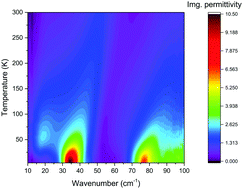Belyanchikov, M. A., Z. V. Bedran, M. Savinov, P. Bednyakov, P. Proschek, J. Prokleska, V. A. Abalmasov et al. "Single-particle and collective excitations of polar water molecules confined in nano-pores within a cordierite crystal lattice." Physical Chemistry Chemical Physics 24, no. 11 (2022): 6890-6904.
Abstract

Recently, the low-temperature phase of water molecules confined within nanocages formed by the crystalline lattice of water-containing cordierite crystals has been reported to comprise domains with ferroelectrically ordered dipoles within the a, b-planes which are antiferroelectrically alternating along the c-axis. In the present work, comprehensive broad-band dielectric spectroscopy is combined with specific heat studies and molecular dynamics and Monte Carlo simulations in order to investigate in more detail the collective modes and single-particle excitations of nanoconfined water molecules. From DFT-MD simulations we reconstruct the potential-energy landscape experienced by the H2O molecules. A rich set of anisotropic temperature-dependent excitations is observed in the terahertz frequency range. Their origin is associated with the complex rotational/translational vibrations of confined H2O molecules. A strongly temperature dependent relaxational excitation, observed at radio-microwave frequencies for the electric field parallel to the crystallographic a-axis, E||a is analyzed in detail. The temperature dependences of loss-peak frequency and dielectric strength of the excitation together with specific heat data confirm a ferroelectric order–disorder phase transition at T0 ≈ 3 K in the network of H2O dipoles. Additional dielectric data are also provided for polarization E||b, too. Overall, these combined experimental investigations enable detailed conclusions concerning the dynamics of the confined water molecules that develop within their microscopic energy landscapes.
for full paper see
https://pubs.rsc.org/en/content/articlelanding/2022/cp/d1cp05338h/unauth
… For terahertz measurements, a time-domain TeraView 3000
spectrometer was employed to directly determine the spectra of the real ε' and imaginary ε"
parts of the dielectric permittivity from the complex (amplitude and phase)
transmission …
